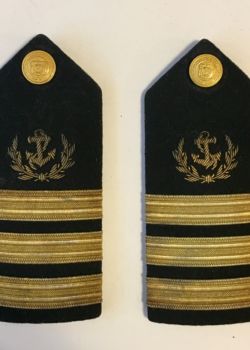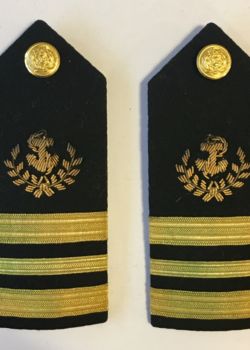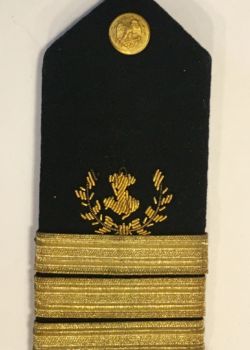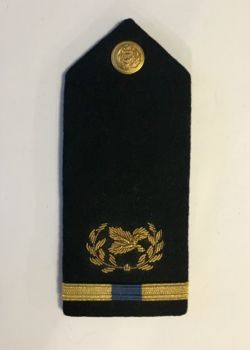United States Maritime Service Shoulder Boards
United States Maritime Service took its uniform and insignia cues from the U.S. Coast Guard and U.S. Navy; U.S. Code called for adherence to the rank structure of the former. Just as the relatively new U.S. Coast Guard placed its distinguishing device – a shield – in the place of the U.S. Navy officer executive star or corps device, the USMS followed the same precedent. Given that the Service was young, it was struggling to find a unified visual identity at the time of the United States’ entry into the Second World War.
During the war, the USMS had three devices on its shoulder boards: a stylized USMS shield in Art Deco style, a “Gold shield of U.S. Maritime Commission,” and an anchor or a corps device within a wreath. The device, along with construction of board, buttons, design of wreath, strap material, and stitching pattern may be used to date a shoulder board – and taken altogether, speak of the organizational changes within the USMS.
The Art Deco shield – as seen in the header image – was reproduced in bullion on shoulder boards and cuff devices and was worn by all commissioned officers of the USMS beginning in 1938. By March 1943, this device was abandoned for the familiar corps device within a wreath. This diverged from the U.S. Coast Guard wherein U.S. Navy corps device capped the shield. The Gold shield – or the central shield of the U.S. Maritime Commission logo – appeared as early as 1938 on the cuffs of District Instructor attached to the U.S. Maritime Commission Cadet Corps; it also appeared as a device on both the former and latter’s shoulder boards. The Gold shield disappeared from Cadet Corps uniforms by 1944. By contrast, District Instructors used the same shield device through 1942 and abandoned it in 1943 around the same time as the mass re-branding and re-design of USMS insignia. For a brief period in 1943 – between February and July 1942 – District Instructor shoulder boards used the U.S. Coast Guard button; this was due to the Cadet Corps instruction and USMS moving to the U.S. Coast Guard. by instructors when the instruction of the Cadet Corps was assumed by the U.S. Coast Guard; afterward, this changed to a USMS button when the Cadet Corps and all seamen training became the responsibility of the USMS.
1938-1942
1943 regulations
1942-present
1944 engineer corps
staff corps 1940s
warrant officers 1940s
References
Bunkley, Joel William. Military and naval recognition book; a handbook on the organization, uniforms

















































